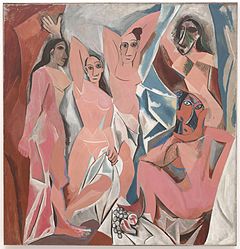
Back Modernisme Afrikaans Klassische Moderne ALS حركة حداثية Arabic تاعصرييت ARY حركه حداثيه ARZ আধুনিকতাবাদ Assamese Modernizm Azerbaijani مودرنیزم AZB Мадэрнізм Byelorussian Мадэрнізм BE-X-OLD

Modernism was an early 20th-century movement in literature, visual arts, and music that emphasized experimentation, abstraction, and subjective experience.[1] Philosophy, politics, architecture, and social issues were all aspects of this movement. Modernism centered around beliefs in a "growing alienation" from prevailing "morality, optimism, and convention"[2] and a desire to change how "human beings in a society interact and live together".[3]
The modernist movement emerged during the late 19th century in response to significant changes in Western culture, including secularization and the growing influence of science. It is characterized by a self-conscious rejection of tradition and the search for newer means of cultural expression. Modernism was influenced by widespread technological innovation, industrialization, and urbanization, as well as the cultural and geopolitical shifts that occurred after World War I.[4] Artistic movements and techniques associated with modernism include abstract art, literary stream-of-consciousness, cinematic montage, musical atonality and twelve-tonality, modernist architecture, and urban planning.[5]
Modernism took a critical stance towards the Enlightenment concept of rationalism. The movement also rejected the concept of absolute originality — the idea of "creation from nothingness" — upheld in the 19th century by both realism and Romanticism, replacing it with techniques of collage,[6] reprise, incorporation, rewriting, recapitulation, revision, and parody.[a][b][7] Another feature of modernism was reflexivity about artistic and social convention, which led to experimentation highlighting how works of art are made as well as the material from which they are created.[8] Debate about the timeline of modernism continues, with some scholars arguing that it evolved into late modernism or high modernism.[9] Postmodernism, meanwhile, rejects many of the principles of modernism.[10][11][12]
- ^ "Modernism". Archived from the original on 17 May 2024. Retrieved 17 May 2024.
- ^ 'Modernism (art)', Britannica online
- ^ 'Social structure, Britannica online
- ^ "How did WWI reshape the modern world?". USC Today. 9 November 2018. Archived from the original on 4 May 2024. Retrieved 4 May 2024.
- ^ "What is Modernism?". www.utoledo.edu. Archived from the original on 5 May 2024. Retrieved 5 May 2024.
- ^ Eco (1990) p. 95
- ^ Cite error: The named reference
Childs2000p17was invoked but never defined (see the help page). - ^ Gardner, Helen; de la Croix, Horst; Tansey, Richard G.; Kirkpatrick, Diane (1991). Gardner's Art through the Ages. San Diego, CA: Harcourt Brace Jovanovich. p. 953. ISBN 0-15-503770-6.
- ^ Morris Dickstein, "An Outsider to His Own Life", Books, The New York Times, August 3, 1997; Anthony Mellors, Late Modernist Poetics: From Pound to Prynne.
- ^ "Postmodernism: definition of postmodernism". Oxford dictionary (American English) (US). Archived from the original on 4 May 2016. Retrieved 16 February 2018 – via oxforddictionaries.com.
- ^ Ruth Reichl, Cook's November 1989; American Heritage Dictionary's definition of "Postmodern" Archived 15 June 2018 at the Wayback Machine
- ^ Mura, Andrea (2012). "The Symbolic Function of Transmodernity". Language and Psychoanalysis. 1 (1): 68–87. doi:10.7565/landp.2012.0005 (inactive 1 November 2024).
{{cite journal}}: CS1 maint: DOI inactive as of November 2024 (link)
Cite error: There are <ref group=lower-alpha> tags or {{efn}} templates on this page, but the references will not show without a {{reflist|group=lower-alpha}} template or {{notelist}} template (see the help page).